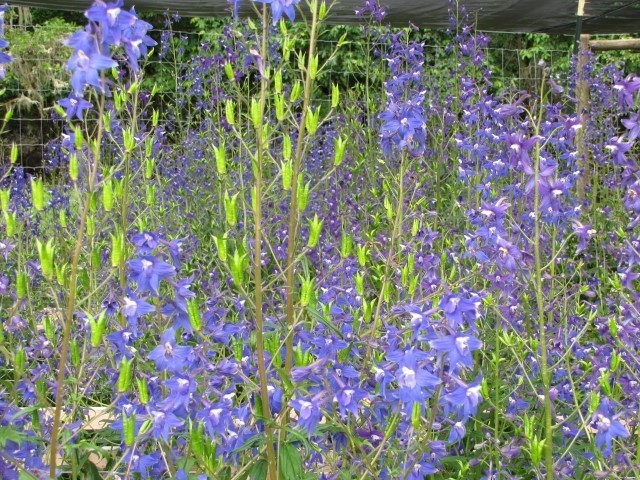Poison Delphinium
(Delphinium trolliifolium)
Poison Delphinium (Delphinium trolliifolium)
/
/

© Gail A Baker
CC BY 4.0
Image By:
© Gail A Baker
Recorded By:
Copyright:
CC BY 4.0
Copyright Notice:
Photo by: © Gail A Baker | License Type: CC BY 4.0 | License URL: http://creativecommons.org/licenses/by/4.0/ | Uploader: ribes2018 | Publisher: iNaturalist |

























Estimated Native Range
Summary
Delphinium trolliifolium, commonly known as poison delphinium or Columbian larkspur, is a perennial herb native to moist meadows, streambanks, and forest clearings in the Pacific Northwest, specifically Washington, Oregon, and northern California. It can exceed one meter in height and features shiny, deeply lobed leaves that are typically broad and resemble those of a trollius, hence the species name. From late spring to early summer, it produces an inflorescence of widely spaced, deep blue flowers with long, backward-projecting spurs, which are quite showy and attract pollinators such as bees and butterflies.
Poison delphinium is valued for its vibrant blue flowers and is used in wildflower gardens and naturalistic plantings. However, it should be handled with care due to its toxic alkaloids, which are poisonous to livestock and humans if ingested. It prefers moist, well-drained soils and can tolerate partial shade, although it flourishes in full sun. While it is relatively easy to grow, it may require staking due to its tall stature. There are no popular garden cultivars of this species, likely due to its toxic properties. Gardeners should be aware of its potential to self-seed and spread within suitable habitats.CC BY-SA 4.0
Poison delphinium is valued for its vibrant blue flowers and is used in wildflower gardens and naturalistic plantings. However, it should be handled with care due to its toxic alkaloids, which are poisonous to livestock and humans if ingested. It prefers moist, well-drained soils and can tolerate partial shade, although it flourishes in full sun. While it is relatively easy to grow, it may require staking due to its tall stature. There are no popular garden cultivars of this species, likely due to its toxic properties. Gardeners should be aware of its potential to self-seed and spread within suitable habitats.CC BY-SA 4.0
Plant Description
- Plant Type: Herb
- Height: 3-6 feet
- Width: 1-2.5 feet
- Growth Rate: Slow, Moderate
- Flower Color: Blue, Purple, White
- Flowering Season: Spring, Summer
- Leaf Retention: Deciduous
Growth Requirements
- Sun: Full Sun
- Water: Medium
- Drainage: Medium
Common Uses
Bee Garden, Bird Garden, Butterfly Garden
Natural Habitat
Moist meadows, streambanks, and forest clearings in the Pacific Northwest
Other Names
Common Names: Giant Larkspur, Sierra Larkspur, Cow Poison, Poison Larkspur
Scientific Names: , Delphinium trolliifolium, Delphinastrum trollifolium, Delphinium elatum, Delphinium exaltatum subsp. trolliifolium, Delphinium exaltatum var. trolliifolium,
GBIF Accepted Name: